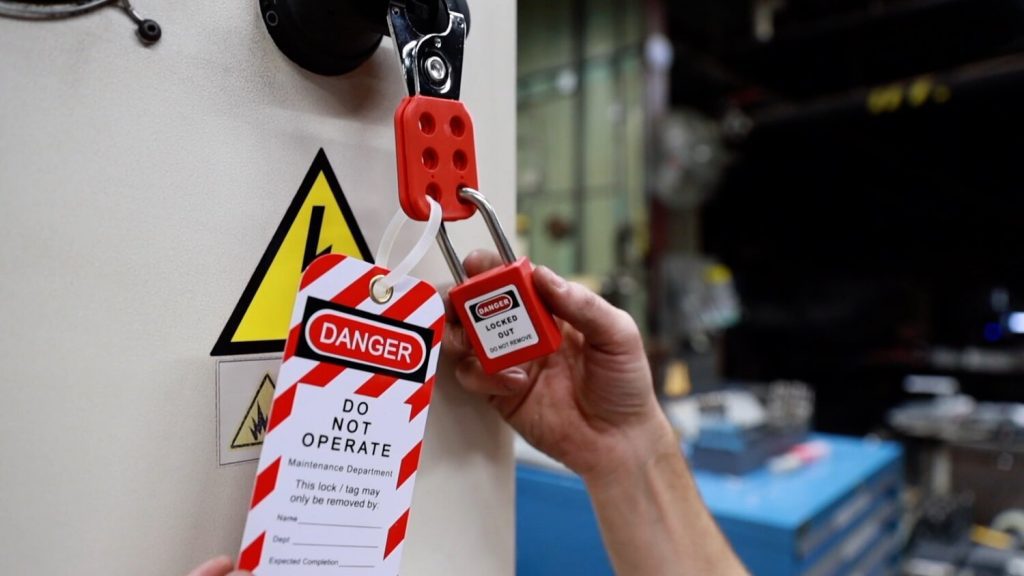Wenn Sie Ihr Auto schon einmal für einen Ölwechsel in eine Werkstatt gebracht haben, bittet Sie der Techniker als erstes, die Schlüssel aus dem Zündschloss zu ziehen und auf das Armaturenbrett zu legen. Es reicht nicht aus, sich zu vergewissern, dass das Auto nicht läuft - bevor jemand seine Hände in die Nähe der Ölwanne legt, muss er sicher sein, dass keine Chance besteht, dass der Motor zum Leben erwacht. Indem er das Auto funktionsunfähig macht, schützt er sich selbst - und auch Sie - indem er die Möglichkeit menschlichen Versagens ausschließt. Dasselbe Prinzip gilt auch für Maschinen auf der Baustelle. Aus diesem Grund haben wir Lockout-Tagout-Verfahren eingeführt.

Was genau ist also ein Lockout-Tagout-Verfahren?
Lockout/Tagout (LOTO) ist eine Reihe von Verfahren mit denen sichergestellt wird, dass die Geräte abgeschaltet, nicht betriebsbereit und (gegebenenfalls) spannungsfrei sind. So können Wartungs- und Reparaturarbeiten an der Anlage sicher durchgeführt werden. Jedes Arbeitsplatzszenario, an dem Geräte beteiligt sind, die zu einer unbeabsichtigten Freisetzung gefährlicher Energie führen könnten, erfordert die Anwendung von Lockout/Tagout-Verfahren. In diesem Zusammenhang umfasst der Begriff "gefährliche Energie" nicht nur Elektrizität, sondern auch andere Energieformen wie pneumatischen Druck, Hydraulikdruck und Gas. Der Zweck der LOTO-Verfahren besteht darin, sowohl die direkte Exposition gegenüber dieser Energie zu verhindern als auch Schäden zu vermeiden, die durch Maschinen oder Objekte verursacht werden, die durch diese Energie bewegt werden könnten (z.B. eine pneumatische Presse, die versehentlich aktiviert wird).
In der Praxis bedeutet Verriegelung die Isolierung von Energie aus dem System (einer Maschine, einem Gerät oder einem Prozess), wodurch das System physisch in einem sicheren Modus verriegelt wird. Die energietrennende Vorrichtung kann ein manuell betätigter Trennschalter, ein Leistungsschalter, ein Leitungsventil oder ein Block sein. Drucktasten, Wahlschalter und andere Schalter zur Steuerung von Stromkreisen gelten nicht als energietrennende Vorrichtungen. In den meisten Fällen verfügen diese Geräte über Schlaufen oder Laschen, die in einer sicheren Position (stromlos) an einem feststehenden Gegenstand verriegelt werden können. Die Verriegelungsvorrichtung (oder Sperrvorrichtung) kann jede Vorrichtung sein, die in der Lage ist, das energieisolierende Gerät in einer sicheren Position zu sichern.

Warum ist LOTO wichtig?
Die Anwendung von Lockout/Tagout-Verfahren gilt als wichtiger Aspekt der Sicherheit am Arbeitsplatz in allen Arbeitsumgebungen, in denen Arbeitnehmer direkt mit Maschinen oder Arbeitsgeräten in Kontakt kommen. Zu den Unfällen, die durch LOTO-Verfahren verhindert werden können, gehören:
- Elektrische Unfälle
- Zerkleinern
- Risswunden
- Brände und Explosionen
- Chemische Belastung
Sicherheitsvorrichtungen wie z.B. Absperrungen oder Schutzvorrichtungen werden an den Systemen installiert, um die Sicherheit der Arbeiter zu gewährleisten, während diese Systeme betrieben werden. Bei Tätigkeiten wie Wartung, Reparatur oder Einrichtung oder bei der Beseitigung von Staus, Verstopfungen oder falsch ausgerichteten Zuführungen können diese Sicherheitsvorrichtungen entfernt werden, wenn andere Kontrollen vorhanden sind, um die Gefahren zu verringern oder zu beseitigen. Ein Lockout/Tagout-Programm und Verfahren für diese Szenarien verringern das Risiko von Verletzungen durch die unbeabsichtigte oder versehentliche Freisetzung gefährlicher Energie.
